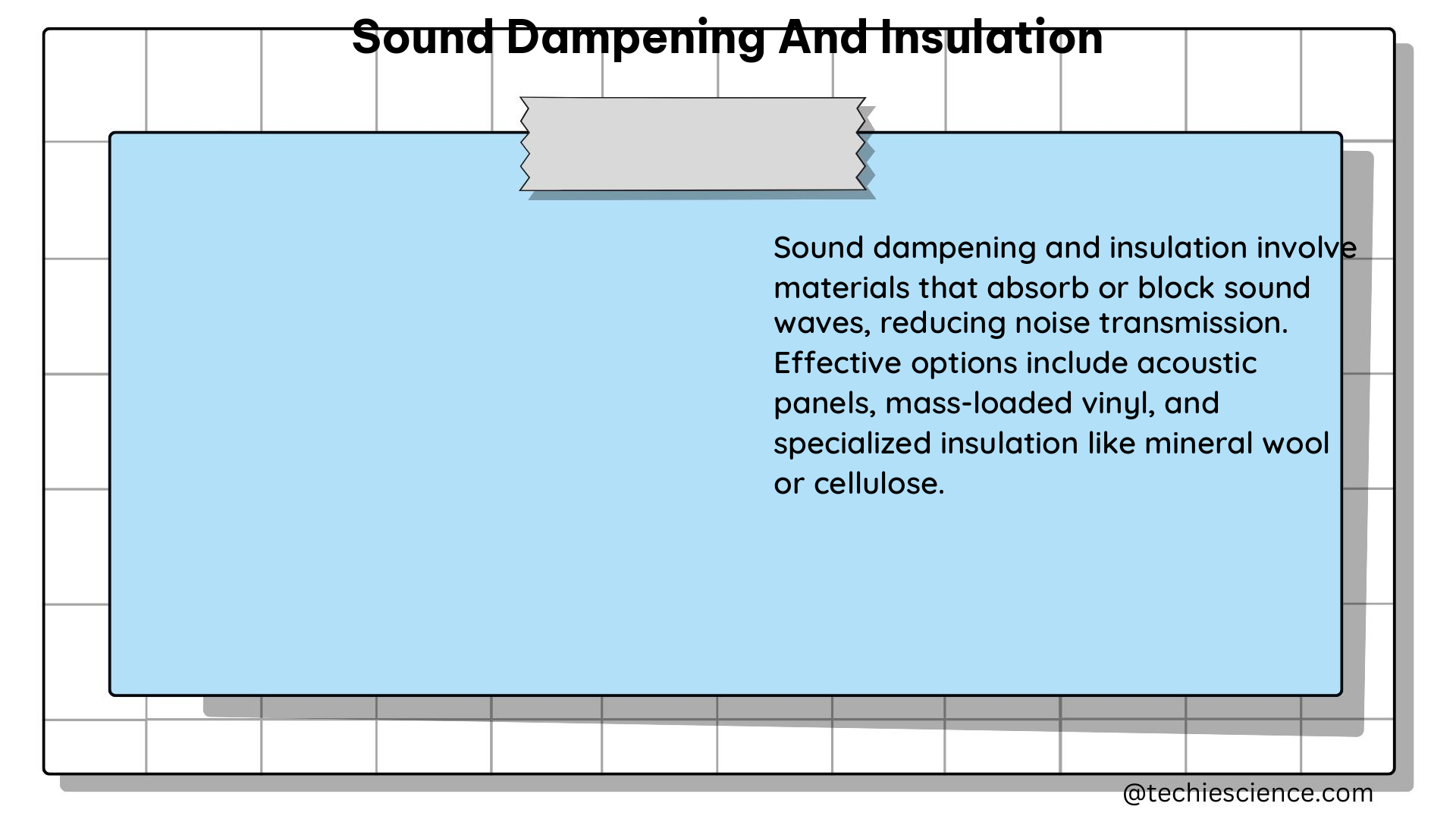Sound dampening and insulation are crucial in various applications, such as reducing noise pollution, improving acoustic comfort in buildings, and enhancing the sound quality in recording studios. This comprehensive guide will delve into the physics principles, theoretical explanations, and technical specifications involved in sound dampening and insulation.
Physics Principles and Theoretical Explanations
Sound Propagation and Intensity
Sound is a form of energy that propagates through a medium, such as air or a solid material, as pressure waves. The intensity of sound is measured in decibels (dB), which quantifies the amplitude of the pressure wave. The relationship between sound pressure (p) and sound intensity (I) is given by the formula:
I = p^2 / ρc
where ρ is the density of the medium, and c is the speed of sound in the medium.
Sound Transmission and Reflection
When sound encounters a barrier, such as a wall or a partition, it can be transmitted, absorbed, or reflected. The sound transmission loss (TL) is a crucial parameter in sound dampening and insulation, and it is defined as the difference in sound pressure level (dB) on either side of the barrier. A higher TL indicates better sound insulation.
The TL of a barrier can be calculated using the formula:
TL = 10 × log10(I1/I2)
where I1 is the sound intensity (dB) on one side of the barrier, and I2 is the sound intensity (dB) on the other side of the barrier.
Sound Transmission Class (STC)
The sound transmission class (STC) is a single-number rating that quantifies the sound insulation properties of a barrier over a wide range of frequencies. The STC rating is calculated using the formula:
STC = 10 × log10(1/T)
where T is the average transmission loss (dB) over a wide range of frequencies.
STC ratings are useful for comparing the sound insulation performance of different barriers. A higher STC rating indicates better sound insulation.
Technical Specifications and Hands-On Details

Mass-Loaded Vinyl
Mass-loaded vinyl is a flexible, heavy material that is effective at reducing sound transmission. It is typically installed on the surface of a barrier, such as a wall or a ceiling, to increase the mass and dampen sound vibrations. A 1/8-inch (3.2 mm) thick mass-loaded vinyl barrier can provide an STC rating of up to 26.
Acoustic Foam
Acoustic foam is a porous material that absorbs sound energy and reduces echo and reverberation. It is often used in recording studios and other applications where sound quality is critical. A 2-inch (51 mm) thick acoustic foam panel can provide an NRC (noise reduction coefficient) rating of up to 0.75.
Fiberglass Insulation
Fiberglass insulation is a lightweight, flexible material that is effective at reducing sound transmission and absorbing sound energy. It is typically installed in walls, ceilings, and floors. A 3.5-inch (89 mm) thick fiberglass insulation batt can provide an STC rating of up to 45.
Installation Techniques
When installing a sound dampening and insulation system, it is essential to ensure that the barrier is continuous and free of gaps or seams. Gaps and seams can significantly reduce the effectiveness of the barrier and compromise the sound insulation performance. Sealing gaps and seams with acoustic caulk or foam can help improve the sound insulation performance of the barrier.
Physics Formulas and Numerical Problems
Sound Transmission Loss (TL)
The sound transmission loss (TL) of a barrier can be calculated using the following formula:
TL = 10 × log10(I1/I2)
where I1 is the sound intensity (dB) on one side of the barrier, and I2 is the sound intensity (dB) on the other side of the barrier.
Example: If the sound intensity on one side of a barrier is 90 dB and the sound intensity on the other side is 70 dB, the TL of the barrier would be:
TL = 10 × log10(90/70) = 10 × log10(1.29) = 10 × 0.11 = 1.1 dB
Sound Transmission Class (STC)
The STC rating of a barrier can be calculated using the following formula:
STC = 10 × log10(1/T)
where T is the average transmission loss (dB) over a wide range of frequencies.
Example: If the average transmission loss of a barrier over a wide range of frequencies is 45 dB, the STC rating of the barrier would be:
STC = 10 × log10(1/45) = 10 × log10(0.022) = 10 × -1.66 = -16.6
Figures and Data Points
- Mass-Loaded Vinyl:
-
A 1/8-inch (3.2 mm) thick mass-loaded vinyl barrier can provide an STC rating of up to 26.
-
Acoustic Foam:
-
A 2-inch (51 mm) thick acoustic foam panel can provide an NRC (noise reduction coefficient) rating of up to 0.75.
-
Fiberglass Insulation:
- A 3.5-inch (89 mm) thick fiberglass insulation batt can provide an STC rating of up to 45.
Reference Links
- Sound Dampening and Insulation: A Comprehensive Guide
- Sound Insulation Measurement with XL2
- Sound Insulation in Older Buildings
In this comprehensive guide, we have explored the physics principles, theoretical explanations, and technical specifications involved in sound dampening and insulation. By understanding the concepts of sound propagation, transmission, and reflection, as well as the properties and performance of common insulation materials, you can design effective sound dampening and insulation systems to reduce noise pollution, improve acoustic comfort, and enhance sound quality in various applications.

The lambdageeks.com Core SME Team is a group of experienced subject matter experts from diverse scientific and technical fields including Physics, Chemistry, Technology,Electronics & Electrical Engineering, Automotive, Mechanical Engineering. Our team collaborates to create high-quality, well-researched articles on a wide range of science and technology topics for the lambdageeks.com website.
All Our Senior SME are having more than 7 Years of experience in the respective fields . They are either Working Industry Professionals or assocaited With different Universities. Refer Our Authors Page to get to know About our Core SMEs.